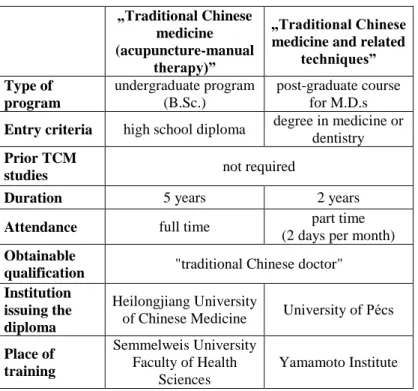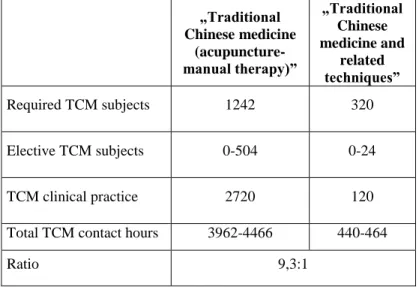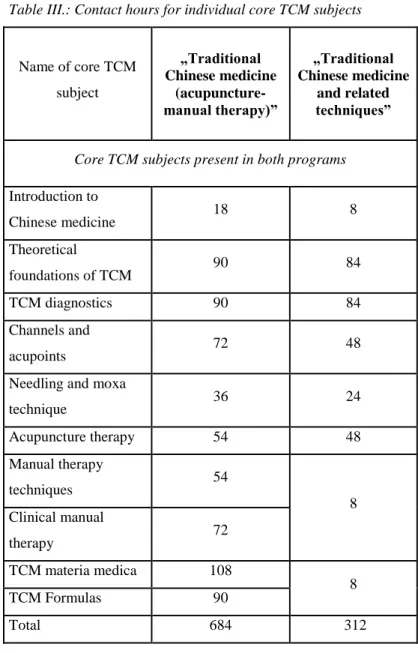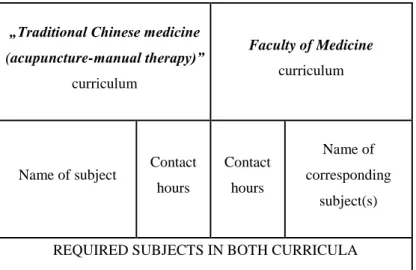A study of traditional Chinese medicine education in Hungary based on the
comparison of curricula
Doctoral theses
Oravecz Márk
Semmelweis University
Doctoral School of Pathological Sciences Health Sciences Program
Supervisor: Mészáros Judit CSc
Official opponents: Szél Ágoston MD, DSc P. Szabó Sándor PhD
Chair of the examination commitee: Forgács Iván MD, CSc Members of the examination commitee: Erdősi Erika PhD
Baji Ildikó PhD
Budapest
2018
Introduction
Traditional Chinese medicine has a unique conceptual system and characteristic therapeutic methods. In addition, not only does it have a system of education with an institutional past of over a millennia but also a clearly defined set of educational standards and subject- structure in the modern university education system.
Objectives
The main objective of this research was to appraise the degree to which „traditional Chinese medicine” (TCM) education in Hungary conforms to international standards of TCM education. A further objective was to determine if there are significant differences between TCM programs in Hungary, and if there are, to evaluate the impact their respective differences may have on the theoretical knowledge and practical skills of their graduates. The final objective of this study was to offer suggestions regarding the future perspectives of TCM education and regulation.
A short introduction of the examined education programs
Currently (in the year 2017) there are two training programs in Hungary where the endpoint qualification is “tradtitional Chinese doctor”. These are: the five year program of Heilongjiang University of Chinese Medicine at Semmelweis University Faculty of Health Sciences and the two year program of the University of Pécs at the Yamamoto Institue in Budapest. The basic parameters of the two programs are presented in Table I.
Table I. Basic parameters of the examined programs
„Traditional Chinese
medicine (acupuncture-manual
therapy)”
„Traditional Chinese medicine and related
techniques”
Type of program
undergraduate program (B.Sc.)
post-graduate course for M.D.s Entry criteria high school diploma degree in medicine or
dentistry Prior TCM
studies not required
Duration 5 years 2 years
Attendance full time part time
(2 days per month) Obtainable
qualification "traditional Chinese doctor"
Institution issuing the diploma
Heilongjiang University
of Chinese Medicine University of Pécs Place of
training
Semmelweis University Faculty of Health
Sciences
Yamamoto Institute
Methods
Study 1.
Comparison of the two programs based on contact hours devoted to the subjects of traditional Chinese medicine. Using standards established by the Ministry of Education of the P.R.C. and the World
Federation of Chinese Medicine Societies we evaluated the number of contact hours devoted to the core TCM subjects in both programs.
Study 2.
Comparison of the two programs based on contact hours devoted to individual core TCM subjects. We examined which subjects and topics of the TCM core curriculum were covered in the two programs and how many contact hours were devoted to each subject respectively.
Study 3.
Comparison of the number of non-TCM core subjects and the contact hours devoted to these subjects in both programs. We examined what subjects of modern medicine the graduates of both programs had studied and the number of contact hours devoted to these subjects.
Standards used
Basic standard for the traditional Chinese medicine theoretical knowledge and technical skills of undergraduate level traditional Chinese medicine majors published by the Ministry of Education of the P.R.C. and World Standard of Chinese Medicine undergraduate (Pre-CMD) Education published by the World Federation of Chinese Medicine Societies (WFCMS).
Results
Results of study 1.
The comparison of the total number of contact hours devoted to TCM core subjects is detailed in table II.
Table II. Total number of contact hours for TCM subjects
„Traditional Chinese medicine
(acupuncture- manual therapy)”
„Traditional Chinese medicine and
related techniques”
Required TCM subjects 1242 320
Elective TCM subjects 0-504 0-24
TCM clinical practice 2720 120
Total TCM contact hours 3962-4466 440-464
Ratio 9,3:1
The number of contact hours devoted to core TCM subjects in the curriculum of the „Traditional Chinese medicine and related techniques” program is less than the minimum set by the WFCMS undergraduate standard (1500 TCM classroom hours and 1500 TCM clinical practice). The number of contact hours devoted to core TCM subjects in the „Traditional Chinese medicine (acupuncture-manual therapy)” program meets the standard requirements.
Results of study 2.
Table III. shows the comparison of the individual core TCM subjects in the two programs.
Table III.: Contact hours for individual core TCM subjects
Name of core TCM subject
„Traditional Chinese medicine
(acupuncture- manual therapy)”
„Traditional Chinese medicine
and related techniques”
Core TCM subjects present in both programs Introduction to
Chinese medicine 18 8
Theoretical
foundations of TCM 90 84
TCM diagnostics 90 84
Channels and
acupoints 72 48
Needling and moxa
technique 36 24
Acupuncture therapy 54 48
Manual therapy
techniques 54
8 Clinical manual
therapy 72
TCM materia medica 108
8
TCM Formulas 90
Total 684 312
Core TCM subjects not present in both programs Clinical TCM subjects
TCM internal
medicine 126 0
TCM gynaecology 72 0
TCM paediatrics 36 0
TCM traumatology 36 0
Total 270 0
Subjects of TCM classic texts Selected acupuncture
classics 72 0
Classical medical
literature 72 0
Chinese medical
history 36 0
On cold damage 54 0
Prescriptions of the
golden coffer 54 0
Total 288 0
Some basic core TCM subjects are taught in similar contact hours in both programs. Nine core subjects are absent and a further four subjects have only a symbolic number of contact hours (4) in the
„Traditional Chinese medicine and related techniques” program. The missing core subjects are clinical subjects and subjects of TCM classical texts. Due to these deficiencies the „Traditional Chinese
medicine and related techniques” program fails to meet the WFCMS standards, while the number of subjects and contact hours of the
„Traditional Chinese medicine (acupuncture-manual therapy)”
program is adequate according to the standards used.
Results of study 3.
Comparison of non-TCM core subjects (subjects of modern medicine) studied by graduates of the two programs was carried out by adding the curriculum of Semmelweis University Faculty of Medicine to the curriculum of the “Traditional Chinese medicine and related techniques” program. The reason for this being that a degree in medicine or dentistry is the entry requisite for this program. Thus a comparison between modern medicine subjects studied by graduates of both programs examined in this study could be carried out, as shown in Table IV.
Table IV. Non-TCM core subjects learned by the graduates of the two examined programs
„Traditional Chinese medicine (acupuncture-manual therapy)”
curriculum
Faculty of Medicine curriculum
Name of subject Contact hours
Contact hours
Name of corresponding
subject(s) REQUIRED SUBJECTS IN BOTH CURRICULA
Anatomy 108
324
Anatomy, histology and embryology I.-IV.
Histology and
embryology 36
Neuroanatomy 36
Medical cellular
biology 54 36
Medical biology
Physiology 90 240 Medical
physiology I.-II.
Biochemistry 54 156 Medical
biochemistry I.-III.
Pathology 72 168 Pathology I.-II.
Microbiology and immunology
72 120
Medical
microbiology I.-II., Immunology
Medical Latin 18 48 Latin I.-II.
Pharmacology
54 120
Pharmacology and pharmacotherapy I.-II.
Diagnostics 126 252
Pathophysiology and clinical laboratory diagnostics I.-II., Laboratory medicine, Medical imaging
techniques, Introduction to
internal medicine, Radiology
Medical ethics 36 24 Bioethics –
medical ethics
Medical genetics 36 48 Genetics and
genomics
Internal medicine
126 312
Internal medicine I.-V.,
Pulmonology, Urology Gynaecology and
obstetrics 54 72 Gynaecology and
obstetrics I.-II.
Surgery
54 132
Experimental and operative surgery, Surgery I.-III.
Neurological locational diagnostics
54
84 Neurology I.-II.
Neurology 54
Rehabilitative
medicine 36 24
Rehabilitation
TOTAL 1170 2200
SUBJECTS REQUIRED IN ONE CURRICULUM, BUT ELECTIVE IN THE OTHER
Medical informatics
systems (elective) 18
36
Biostatistics and the basics of informatics (required) Applied computer
technology in medical devices (elective)
36
- 0 72 Medical chemistry
(required)
- 0 72 Medical biophysics
I.-II. (required) Medical sociology
(elective) 18 24 Medical sociology
(required)
- 0 14 First aid (required)
-
Basics of medical molecular biology (elective)
36 72 Molecular cellular biology (required) The art of
communication (elective)
18
60
Behavioral science I.-II. (medical communication and medical psychology) (required) Applied psychology
(elective)
36
-
0 8
Medical basics of catastrophe management I.-IV.
(required)
Preventive medicine (elective)
36 96
Epidemiology and preventive medicine I.-II.
(required) TCM
otolaryngology (elective)
36 36 Otolaryngology
(required)
- 0 48 Dermatology
(required) Stomatology
(elective) 18 24 Oral surgery and
dentistry (required) TCM orthopaedics
(elective) 36 36 Orthopaedics
(required)
0 24
Psychotherapy in medical practice (required) TCM paediatrics
(elective) 36 120 Paediatrics I.-II.
(required)
- 0 84 Psychiatry I.-II.
(required) Medical law
(elective) 18
24
Medical law, insurance and economics (required) Inrtoduction to
medical economics (elective)
36
Medical insurance
services (elective) 18
-
0 12
Oxyology – emergency medicine (required) General medicine
(elective) 36 12 Family medicine
(required)
-
0 24
Intensive care and aenesthesiology (required)
- 0 36 Traumatology
(required)
- 0 36 Forensic medicine
(required) Opthalmology
(elective) 36 48 Opthalmology
(required)
TOTAL 432 1018
CLINICAL PRACTICE
Clinical practice in a teaching semester
(6th semester) (9 weeks)
480
24
Clinical introduction (2 hrs/week) 160 Nursing summer
practice (4 weeks)
160
Internal medicine summer practice (4 weeks) 160 Surgery summer
practice (4 weeks)
Final year clinical practice (42 weeks)
2240 2240
6th year clinical practice (42 weeks)
Total contact hours without clinical practice
1674 3622
Total contact hours
for non-TCM core subjects
4394 6366
RATIO 1:1,45
The number of contact hours devoted to non-TCM core subjects (modern medicine subjects) in the „Traditional Chinese medicine (acupuncture-manual therapy)” program meets the criteria set by the WFCMS standard. However this number is well below the number of contact hours devoted to these subjects in the curricumum of the Faculty of Medicine. Furthermore in comparison some basic core subjects are missing and certain clinical core subjects are only elective in the curriculum of the „Traditional Chinese medicine (acupuncture-manual therapy)” program.
Conclusions
Traditional Chinese medicine education, and the profession itself, may be said to be in its infancy in Hungary. Even the current laws and regulations tend to use rather vague terminology. Currently, in order to practice the profession designated as “traditional Chinese medicine” graduation from the program “Traditional Chinese medicine and related techniques” is necessary, but this program fails to meet the requirements of a standard TCM core curriculum, only teaching a fraction of TCM knowledge and techniques. The first education program that meets international TCM education standards, the five year “traditional Chinese medicine (acupuncture- manualtherapy” undergraduate program has been operating in Hungary for over 7 years now, but graduates cannot practice
“traditional Chinese medicine”, only the professions designated as
“acupuncture”, “acupressure” and “oriental movement and massage therapy”. In these three areas permits are given, but by law there is no actual recognition of qualifications and no admission to the directory of health care professionals. This legal situation is already a significant improvement, since as of 2013 is has become possible to practice acupuncture with a 5 year undergraduate TCM degree in Hungary. However if we consider current regulations in light of the findings put forth by this research, it may not seem to overly bold to suggest that further corrections of this legal framework may be in order.
It would be more accurate to change the name of the “Traditional Chinese medicine and related techniques” program to “Acupuncture and related techniques” or perhaps to “Medical acupuncture and related techniques”. It would likewise be reasonable to change the
obtainable qualification to “medical acupuncturist” or “acupuncture doctor/physician” instead of using the term “traditional Chinese doctor”. Following this logic, the profession currently labelled
“traditional Chinese medicine” should rather be called “medical acupuncture.”
Graduates of the five year TCM undergraduate curriculum should be able to practice “traditional Chinese medicine”, including all of its therapeutic modalities (especially acupuncture, Chinese manual therapy and Chinese herbal medicine). In accordance with the current situation in western countries, their scope of practice should be limited to traditional Chinese medicine only, but at the same time better integration of TCM professionals into the Hungarian health care system is needed. TCM professionals should be included in the national healthcare register, they should participate in obligatory continuous education and the exact legal boundaries of their profession should be in realistic alignment with their training.
When establishing local TCM training programs international standards regarding content and duration should be observed, but they should also be tailored to characteristics of the local health care system – especially regarding the subjects of modern medicine. The question of how to name the TCM profession in Hungary is also one to be solved in the future. The current legislation calls TCM professionals “persons holding diplomas in the field of traditional Chinese healing.” If we acknowledge that there is a field of knowledge called “traditional Chinese medicine”, then might it not be considered more fitting to call those professionals who have graduated from a training program which conforms to the standards
of TCM undergraduate education “traditional Chinese doctors” and their profession “traditional Chinese medicine”?
The question of what education programs are the most adequate for training professionals who are to carry out traditional Chinese medicine treatments is one that goes beyond the realms of education and legislation: it may also be of great importance in clinical research. It may be reasonable to suppose, that graduates of a training program that fails to meet international TCM education standards will not be able to adequately reproduce the therapeutic methods of Chinese medicine in a clinical study. It is possible, that a training program of a couple hundred contact hours and of several thousand contact hours in TCM will result in graduates with greatly differing clinical skills, thus significantly altering the results of clinical trials. As an example one of the largest scope acupuncture trials (GERAC) may be cited, where the educational requirement for acupuncturists performing treatments was a course of less than 200 contact hours! The question arises: are the results of such trials also relevant to treatments carried out by TCM professional graduating from standard education programs? The relation between different types of TCM education programs and the results of clinical trials remains yet to be explored.
List of publications
Li Z, Yu F, Oravecz M (eds.). A hagyományos kínai orvoslás nemzetközi szabványú kínai-magyar-angol alapterminológiája [International Standard Chinese-Hungarian-English Nomenclature of Chinese Medicine]. Noran Libro Kiadó, Budapest, 2017.
Oravecz M. A hagyományos kínai orvoslás elméleti alapjai [The Theoretical Foundations of Chinese Medicine]. Semmelweis Egyetem Egészségtudományi Kar, Budapest, 2013.
Oravecz M, Kuang H, Mészáros J. (2011) Education and licensing of traditional Chinese doctors in China. New Medicine, 1/2011: 30-34.
Oravecz M, Mészáros J. (2012) A hagyományos kínai orvoslás elméleti háttere és alkalmazása Kínában [The Theoretical Background of Chinese Medicine and Current Applications in China]. Orv Hetil, 153(19): 723–731.
Oravecz M, Mészáros J, Yu F, Horváth I. (2014) A hagyományos kínai orvoslás magyarországi szabályozásának egyes problémái és lehetséges megoldásai az Egyesült Királyság példáján keresztül [Some Problems Regarding the Hungarian regulation of Chinese medicine and possible solutions based on examples from the United Kingdom]. Orv Hetil, 155(15): 576–582.
Oravecz M, Mészáros J, Yu F. (2017) A hagyományos kínai orvosképzés követelményrendszere [Education standards of Chinese medicine]. Interdiszciplináris Magyar Egészségügy, 16(8): 54-57.
Oravecz M, Mészáros J, Yu F, Horváth I. (2018) Az akupunktőri képesítések szerepe az akupunktúra randomizált, kontrollált vizsgálataiban [The role of acupuncturists’ qualifications in
randomized controlled trials of acupuncture]. Lege Artis Medicinae, 28(3): 107-115.



